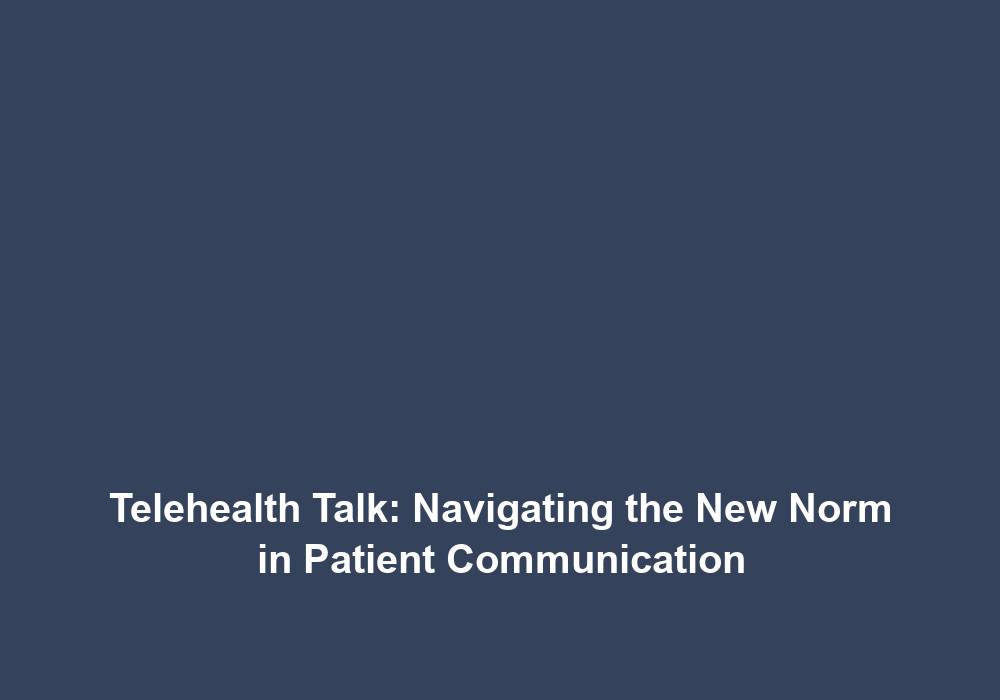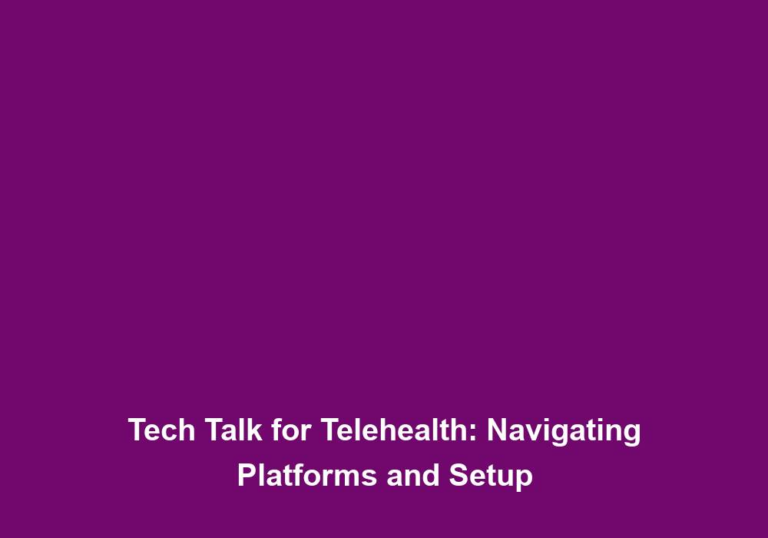Telehealth Talk: Navigating the New Norm in Patient Communication
In today’s rapidly advancing digital age, telehealth has emerged as a revolutionary solution, transforming the landscape of patient communication. This modern approach utilizes technology to bridge the gap between healthcare providers and patients, offering convenient and efficient healthcare services from the comfort of one’s own home. As the world adapts to the new norm imposed by the COVID-19 pandemic, the adoption of telehealth has accelerated, bringing numerous benefits and challenges. In this article, we will explore the various aspects of telehealth and discuss how to navigate this new frontier in patient communication.
The Rise of Telehealth
Telehealth, also known as telemedicine, refers to the delivery of healthcare services and information through digital communication channels. This method enables healthcare professionals to diagnose, treat, and monitor patients remotely, eliminating the need for physical office visits. The rise of telehealth can be attributed to several factors, including advancements in technology, increased internet accessibility, and the need for social distancing during the pandemic.
Telehealth has become increasingly popular due to its ability to provide convenient and accessible healthcare services. With telehealth, patients no longer have to travel long distances or face transportation challenges to receive medical care. This is especially beneficial for individuals with limited mobility or those living in remote areas where healthcare facilities may be scarce. Additionally, telehealth allows patients to schedule appointments and consult with healthcare providers from the comfort of their own homes, saving them time and effort.
Advancements in technology have played a significant role in the rise of telehealth. The availability of high-speed internet and the widespread use of smartphones and other digital devices have made it easier for patients to connect with healthcare providers remotely. Video conferencing platforms and secure messaging applications have made virtual consultations and communication between patients and healthcare professionals seamless and efficient.
Benefits of Telehealth
1. Convenience and Accessibility
Telehealth offers unparalleled convenience and accessibility, particularly for individuals with limited mobility, living in remote areas, or facing transportation challenges. Patients can easily schedule appointments, consult with healthcare providers, and receive necessary medical advice without leaving their homes. This accessibility promotes more frequent and timely communication between patients and healthcare professionals, leading to better overall healthcare outcomes.
In addition to convenience, telehealth also improves access to healthcare services for underserved populations. Individuals who live in rural or medically underserved areas often face difficulties in accessing healthcare due to geographical barriers. Telehealth bridges this gap by allowing patients to connect with healthcare providers remotely, ensuring that they receive the care they need regardless of their location.
Telehealth also eliminates the need for patients to take time off work or arrange transportation for in-person visits, resulting in cost savings. By leveraging telehealth services, patients can potentially save on transportation costs, parking fees, and childcare expenses associated with in-person medical visits. Moreover, telehealth eliminates the need for long wait times, reducing the loss of productivity often experienced during traditional medical appointments. Additionally, healthcare providers can optimize their time and resources by efficiently attending to patients through virtual consultations.
2. Cost Savings
By leveraging telehealth services, patients can potentially save on transportation costs, parking fees, and childcare expenses associated with in-person medical visits. Moreover, telehealth eliminates the need for long wait times, reducing the loss of productivity often experienced during traditional medical appointments. Additionally, healthcare providers can optimize their time and resources by efficiently attending to patients through virtual consultations.
Telehealth also offers cost savings for healthcare providers. By conducting virtual consultations, healthcare professionals can see more patients in a day, reducing overhead costs associated with maintaining physical clinics. This allows healthcare providers to allocate their resources more efficiently and provide quality care to a larger number of patients.
3. Enhanced Patient Engagement and Empowerment
Telehealth empowers patients to take an active role in their healthcare journey. With access to their medical records, test results, and treatment plans, patients can better understand their conditions and actively participate in shared decision-making with healthcare providers. This increased engagement leads to better patient satisfaction and improved health outcomes.
Through telehealth platforms, patients can access educational resources, participate in virtual support groups, and engage in self-management programs tailored to their specific conditions. This comprehensive approach to patient care promotes self-efficacy and empowers patients to make informed decisions about their health.
Telehealth also allows for continuous monitoring and follow-up care. Patients can use wearable devices to track their vital signs and share the data with healthcare providers, facilitating proactive management of chronic diseases. Regular remote monitoring and follow-up appointments enable healthcare providers to closely track patients’ progress, detect early warning signs, and make necessary adjustments to treatment plans. This seamless continuum of care helps prevent complications, reduce hospital readmissions, and improve overall patient well-being.
4. Continuity of Care
Telehealth ensures continuity of care, especially for individuals with chronic diseases or complex medical conditions. Regular remote monitoring and follow-up appointments enable healthcare providers to closely track patients’ progress, detect early warning signs, and make necessary adjustments to treatment plans. This seamless continuum of care helps prevent complications, reduce hospital readmissions, and improve overall patient well-being.
Challenges and Solutions
While telehealth presents numerous advantages, it is not without its challenges. Overcoming these obstacles is crucial to fully harness the potential of telehealth and ensure the best possible patient experience. Here are some common challenges and their corresponding solutions:
1. Technological Barriers
Not all patients have access to reliable internet connections or possess the necessary technological literacy to navigate telehealth platforms. It is essential for healthcare providers to ensure equitable access to telehealth services by offering alternative communication methods, such as telephone consultations or video calls through user-friendly applications.
Healthcare providers can also collaborate with community organizations and government agencies to address the issue of internet connectivity in underserved areas. By advocating for improved infrastructure and providing resources for technological literacy, healthcare providers can help bridge the technological gap and ensure that all patients have equal access to telehealth services.
2. Privacy and Security Concerns
Protecting patient privacy and maintaining data security are paramount in telehealth. Healthcare providers must comply with stringent privacy regulations, such as the Health Insurance Portability and Accountability Act (HIPAA), to safeguard patient information. Implementing secure communication platforms, encrypted data transmission, and robust authentication procedures can help mitigate privacy and security risks.
Healthcare organizations should invest in secure telehealth platforms that adhere to industry standards and regulations. This includes implementing encryption protocols to protect patient data during transmission and storage. Healthcare providers should also educate patients about the importance of privacy and security in telehealth and provide clear guidelines on how their data will be handled and protected.
3. Establishing Trust
Building trust between patients and healthcare providers in a virtual setting can be challenging. Healthcare professionals should prioritize clear and empathetic communication, actively listening to patients’ concerns, and providing thorough explanations of diagnoses and treatment plans. By establishing a rapport and fostering a supportive environment, trust can be nurtured despite the physical distance.
Healthcare providers can also leverage technology to enhance trust in telehealth. For example, virtual waiting rooms can provide patients with a sense of security and privacy before their appointments. Secure messaging platforms can allow patients to ask questions and receive timely responses from healthcare providers, further strengthening the patient-provider relationship.
4. Adapting Clinical Practices
Telehealth requires healthcare providers to adapt their clinical practices to the virtual environment. This may involve creating standardized protocols for remote patient assessments, utilizing telemonitoring devices, and implementing virtual prescription management systems. Continuous training and education programs for healthcare professionals ensure that they remain up-to-date with the latest telehealth practices and technologies.
Healthcare organizations should invest in training programs that equip healthcare professionals with the necessary skills and knowledge to provide high-quality telehealth services. This includes training on conducting virtual examinations, interpreting remote monitoring data, and effectively communicating with patients through digital platforms. By empowering healthcare professionals with the tools they need, they can deliver optimal care to patients in the telehealth setting.
The Future of Telehealth
As telehealth becomes increasingly integrated into the healthcare system, the future holds limitless possibilities. Advancements in artificial intelligence, remote monitoring devices, and virtual reality are expected to revolutionize patient communication and treatment delivery. Furthermore, the widespread adoption of telehealth is likely to lead to the development of comprehensive electronic health record systems, enabling seamless sharing of patient information between healthcare providers for optimal collaborative care.
Artificial intelligence (AI) has the potential to enhance telehealth by enabling intelligent triage systems, predicting disease outcomes, and providing personalized treatment recommendations. Remote monitoring devices, such as wearable sensors and home-based diagnostic tools, can enable healthcare providers to remotely monitor patients’ health status and intervene early when necessary. Virtual reality (VR) technology can create immersive experiences that simulate real-life medical scenarios and facilitate training for healthcare professionals.
The integration of telehealth with electronic health record (EHR) systems is another area of development. Comprehensive EHR systems can enable seamless sharing of patient information between healthcare providers, ensuring that all relevant data is readily available for informed decision-making. This interoperability enhances collaborative care and reduces the burden of redundant testing and paperwork for patients.
In conclusion, telehealth is a game-changer in patient communication, offering convenience, accessibility, and better healthcare outcomes. While challenges exist, proactive solutions can ensure equitable access, privacy protection, trust-building, and seamless clinical practices. As we navigate this new norm in patient communication, embracing the potential of telehealth will undoubtedly shape the future of healthcare delivery, enhancing patient care and well-being.







